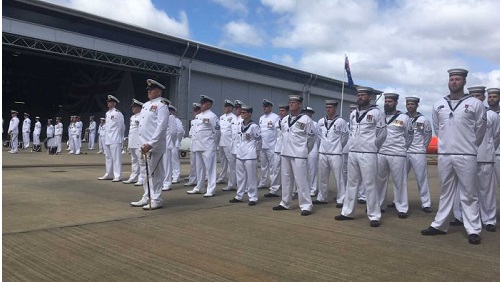Australian Navy commissions first unmanned aircraft squadron
by ANZDD on 26-Oct-2018

The Australian Navy has commissioned its first experimental squadron to explore the use of unmanned aircraft systems at sea.
There have been a number of people working with unmanned aircraft since the 1950s, when towing aircraft were used in training exercises.
Since 2012, newer models of these aircraft, which function like a highly sophisticated drone, have been equipped with a satellite and cameras.
A group of sailors have been doing preliminary experimentation, gaining flight experience and learning how to launch the aircraft from ships while on deployment.
The Navy is currently operating two systems, which squadron 822X will continue experimenting with.
Lieutenant Commander Ben Crowther has been working with the Naval Unmanned Aircraft Systems Unit (NUASU) for the past few years before the formal transition to 822X Squadron.
He said it had been a huge learning curve for everyone involved, but had also been successful in a multitude of ways from cost-effectiveness to the safety of personnel.
"I have a background in flying and I can tell you, it's very different flying an aircraft from a computer in an air-conditioned box."
What aircraft are being used?
The Schiebel Camcopter S-100, which can carry payloads such as electro-optics and infrared sensors, is one aircraft being researched.
This is a $2 million piece of equipment that can carry out of a number of functions traditionally done by manned helicopters.
While a regular helicopter would require three men to be on board and cost $60 million, this system is significantly cheaper and can carry out work that is risky for people normally on board.
The Insitu ScanEagle, a small, long-endurance, low-altitude aircraft is a fixed-wing aircraft used for identifying friends or foes at sea.
ScanEagles and Camcopters are being used for surveillance, intelligence gathering and reconnaissance.
Experimental phase begins
The Navy will spend the next three to five years experimenting with unmanned aircraft systems before purchasing more in 2022-23.
Commanding Officer Michael Rainey has taken over from Lieutenant Commander Crowther, and will lead the newly formed squadron moving forward.
"The purpose of the aircraft are to extend the eyes and ears of ships at sea," Commanding Officer Rainey said.
"They have much greater endurance than our manned aircraft. For example, the fixed-wing ScanEagle can stay airborne for 12 hours on 3 litres of fuel.
"The downside at the moment is they are not as reliable as our manned aircraft."
New squadron commissioned
The new squadron has been commissioned to operate the aircraft for the Navy.
Members will be sent on deployments, work on the engineering aspects of the systems, and be asked to look at the operational procedures of the aircraft on land and at sea.
There are eight unmanned aircraft operating in the Navy, but from the new squadron's research, the Navy will purchase more systems.
The 822X squadron is the first squadron to use the suffix X, to symbolise the experimental aspect of its role.
The newly inducted Australian Chief of Navy Michael Noonan commissioned the squadron at HMAS Albatross at Nowra this week, and said it was a significant moment for the organisation.
"In the near future, unmanned systems will be deployed to every operational theatre," Vice Admiral Noonan said.
"Autonomous systems are growing in importance and 822X Squadron will realise the full potential that these technologies present."
Source: ABC News







